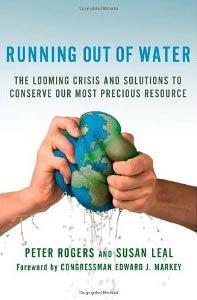Book Notes
 Peter Rogers and Susan Leal, Running Out of Water: The Looming Crisis and Solutions to Conserve Our Most Precious Resource (New York: Palgrave Macmillan, 2010), 245pp.
Peter Rogers and Susan Leal, Running Out of Water: The Looming Crisis and Solutions to Conserve Our Most Precious Resource (New York: Palgrave Macmillan, 2010), 245pp.
Peter Rogers, a professor of environmental engineering at Harvard, and Susan Leal, the former general manager of the San Francisco Public Utilities Commission, sound the alarm for the "collision course" that the world is on regarding the increasing demand and finite supply of water. In the last one hundred years, the world's population has increased threefold, while the demand for water has increased six fold. And unlike oil, they point out, there is no substitute for water. What makes their book so compelling, though, is not the note of fear but of hope, for most of their focus is on case studies in which stake holders have taken positive actions to make huge differences.
The Orange County Water District in California has instituted an award-winning program of recycling sewer water. St. Petersburg, the first city to use recycled water for irrigation back in 1976, has a "cash for grass" program, as does dry and dusty Las Vegas. As a result, Southern Nevada used "26 billion gallons less water in 2009 than it did back in 2002, despite a population increase of 400,000 during that span" (43-44). Agriculture, the biggest user and waster of water (47), also boasts positive examples, like modern irrigation systems in Nebraska, or a system of buying and selling water interests in Australia. Technological innovation, consumer education, and public-political support have combined to upgrade aging sewer and sanitation systems in San Francisco, Brazil, and Pakistan, leading to better environmental practices, basic sanitation, and public health.
In one of the more complicated chapters, Rogers and Leal explore economic theories to consider the complex task of placing a value on water. In Boston, for example, "from 1986 to 2009, the price of water increased tenfold while the demand for water dropped by 35 percent" (143). One entire chapter illustrates how the "FOG" (fat, oil and grease) from restaurants clogs public sewers but can also be turned into bio-diesel fuel. The same is true of the 1.5 million pounds of chicken blood (!) that flow from Foster Farms every week. Another chapter explores the complicated problems of trans-boundary conflicts over rivers. For over 4,000 years of human settlement, the Nile River has meandered 4,000 miles across what are now ten countries. How to parse the conflicts between "upstream" and "downstream" users over navigation, fishing, pollution, and especially diversion and withdrawals from dams? In a final chapter, the authors consider the phenomenon of bottled water (see the book Bottled and Sold by Peter Gleick). The good news in all this, insist Rogers and Leal, is that creative alternatives and best-practices already exist; the collision course is avoidable.


